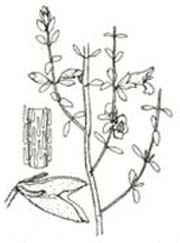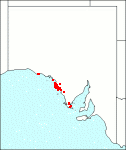Family: Lamiaceae
Prostanthera calycina
Citation:
F. Muell. ex Benth., Fl. Aust. 5:107 (1870).
Synonymy: Not Applicable Common name: Red mintbush.
Description:
Small more or less prostrate shrub, c. 0.5 m high; branches moderately to densely hairy, sparsely glandular; hairs on branches 0.1-0.5 but usually 0.3-0.4 mm long, stiff and straight for most of their length, appressed, antrorse; leaves arranged along the axis and branches, not clustered on short shoots, usually sparsely, rarely densely hairy, occasionally glabrous; hairs similar to those of branches; petiole 0.8-1.4 mm long, flattened, densely hairy with hairs similar to those of branches; lamina elliptic to ovate-oblong, 4-14 mm long, 3-5 mm wide; base obtuse to subattenuate; margin entire; apex obtuse to rounded; hairs more or less restricted to the midrib and margin of the abaxial surface, more or less confined to the margin and the apex of the adaxial surface; venation indistinct or not visible.
Pedicel 2.5-4.5 rarely 7 mm long, often maroon, densely hairy with hairs similar to those of branches; bracteoles inserted at the base of the calyx, narrowly obovate to more or less oblong, 1.5-4 mm long, c. 0.5 mm wide; calyx 8-14 mm long, usually maroon, sometimes green; outer surface sparsely to moderately hairy, particularly along the veins, moderately glandular; inner surface glabrous; tube 6-8 mm long; lobes triangular, 4-6 mm long, 5-7 mm wide; corolla 17.5-22 mm long, red; outer surface sparsely to moderately hairy distally with hairs c. 0.1 mm long; inner surface glabrous; tube 13-15 mm long; lower median lobe obovate, c. 4 mm long, c. 3 mm wide, more or less recurved to reflexed; lateral lobes narrow, triangular to ovate, c. 3 mm long, c. 3 mm wide, recurred to reflexed; upper median lobe-pair broadly triangular, c. 5 mm long, 5-6 mm wide; stamens inserted c. 8.5 mm above the base of the corolla; filaments c. 5.5 mm long, with a few scattered minute glandular trichomes; anthers 1.5-2 mm long; connective extended to form a short basal appendage 0.4-0.8 rarely only 0.1 mm long; pistil 12-15 mm long; ovary 0.5-0.7 mm long; style 11-14 mm long; stigma lobes to 0.3 mm long.
Fruit unknown.

| Flowering branch and calyx with appressed hairs on stem.
|
Image source: fig. 555G in Jessop J.P. & Toelken H.R. (Ed.) 1986. Flora of South Australia (4th edn).
|
|
|
Distribution:
|
This species occurs on calcarenite ridges and in sandy loams of undulating calcreted plains in mallee communities. Commonly associated with Eucalyptus incrassata, E. oleosa, E. socialis, and frequently with Melaleuca, Pittosporum, Santalum acuminatum, and various shrubs (such as Grevillea, Hakea and Spyridium).
S.Aust.: EP.
|
Conservation status:
native
Flowering time: No flowering time is available |

SA Distribution Map based
on current data relating to
specimens held in the
State Herbarium of South Australia
|
Biology:
This species has a very distinctive hair type which is not found in any other taxon of section Klanderia. The hairs are appressed, straight for most of their length, stiff, and directed towards the distal part of the organ on which they occur.
Taxonomic notes:
This species is possibly at risk from a conservation viewpoint.
Author:
Not yet available
|

